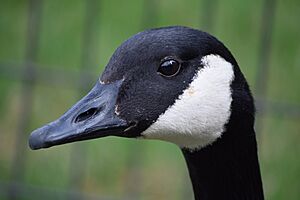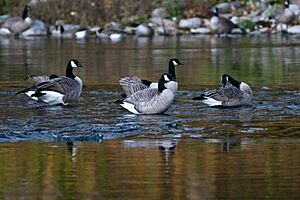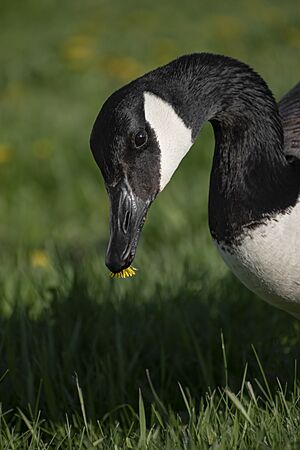Canada goose facts for kids
Quick facts for kids Canada goose |
|
|---|---|
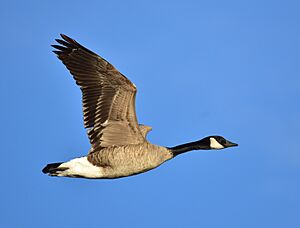 |
|
| At Seedskadee National Wildlife Refuge | |
| Conservation status | |
| Scientific classification | |
| Genus: |
Branta
|
| Species: |
canadensis
|
| Subspecies | |
|
|
 |
|
| Canada goose distribution: Summer range (native) Year-round range (native) Wintering range (native) Summer range (introduced) Year-round range (introduced) Wintering range (introduced) Summer range (cackling goose) | |
| Synonyms | |
|
Anas canadensis Linnaeus, 1758 |
|
The Canada goose (Branta canadensis) is a large wild goose. It has a black head and neck with white cheeks and a brown body. You can find them in North America, where they are native. Sometimes, they fly across the Atlantic Ocean to northern Europe.
These geese have also been brought to other places like France, the United Kingdom, New Zealand, and Japan. Canada geese mostly eat plants. They often live near fresh water but can also be found in salty marshes.
Canada geese are very good at living near people. They build nests in cities and farms. This has led to them sometimes being seen as a problem. They can make a lot of noise and be aggressive. They also leave droppings and might eat crops. Sometimes, people feed them, which makes the geese expect food from humans.
Contents
About the Canada Goose
The Canada goose is easy to spot with its black head and neck. It has a white "chinstrap" under its chin. This look helps tell it apart from other geese. There are seven types, or subspecies, of Canada geese. They all look like Canada geese but can be different sizes.
Some smaller Canada geese might look like the cackling goose. Cackling geese are usually much smaller. The smallest cackling goose is only a little bigger than a mallard duck. Canada geese are generally the largest living geese.
How Big Are Canada Geese?
Canada geese are about 75 to 110 centimeters (30 to 43 inches) long. Their wingspan can be from 127 to 185 centimeters (50 to 73 inches). The largest type is called the giant Canada goose. One very large male giant Canada goose weighed about 10.9 kilograms (24 pounds). Its wingspan was 2.24 meters (7.3 feet)! This is the biggest wild goose ever recorded.
Male geese usually weigh between 2.6 and 6.5 kilograms (5.7 to 14.3 pounds). Females look almost the same. They are a bit lighter, weighing 2.4 to 5.5 kilograms (5.3 to 12.1 pounds). Females are also about 10% smaller than males.
Goose Sounds
Male Canada geese make a loud "honk" sound. Females make a shorter, higher-pitched "hrink" sound. When they are upset or protecting their nests, they will hiss. Canada geese use ten different sounds to communicate. Each sound means something different depending on the situation.
Where Do Canada Geese Live?
Canada geese are native to North America. They breed in Canada and the northern United States. Many live in the Great Lakes region. Some Canada geese stay in the southern parts of their breeding range all year. This includes the eastern and Pacific coasts of the United States. In the southern United States and northern Mexico, they mostly visit in winter.
In the early 1900s, there were fewer Canada geese. This was due to too much hunting and losing their homes. One type, the giant Canada goose, was even thought to be gone in the 1950s. But a small group was found in Minnesota in 1962. Thanks to better hunting laws and efforts to save their homes, their numbers have grown.
Growing Populations in Cities
Recently, Canada goose numbers have grown a lot in some areas. Many people now see them as a nuisance. This is because of their droppings, noise, and aggressive behavior. This problem happens partly because there are fewer natural predators. Also, there are many safe, human-made water areas near food. These places include golf courses, parks, and sports fields.
Some Canada geese used to migrate but now stay all year. This is because different types have mixed together. Also, there is plenty of food and safe places in cities. For example, in 2015, Ohio had about 130,000 Canada geese. Many of these geese now live there all year.
Canada Geese Around the World
Canada geese have also reached Northern Europe naturally. They are found in eastern Siberia and eastern China. People also brought them to Europe in the 1600s. King James II of England had them in his park. By the mid-1700s, they lived in France and Great Britain. They were also brought to New Zealand in 1905 for hunting. In some places, they have become a problem.
How Canada Geese Behave

Most Canada geese migrate. This means they fly to warmer places for winter. You can often see large groups flying in a V formation during spring and autumn. In some areas, they no longer migrate. This happens in places with mild weather and enough food all year.
What Do Canada Geese Eat?
Canada geese mainly eat plants. They sometimes eat small insects and fish. They enjoy green plants and grains. When on land, they eat different grasses. They grab a blade of grass with their bill and pull it with a head jerk. They also eat beans, wheat, rice, and corn. In water, they feed on aquatic plants and algae.
In cities, they might even pick food from garbage bins. People in parks sometimes hand-feed them grains. Canada geese like to graze on lawns in open areas. This helps them see any dangers.
How Canada Geese Have Babies
Canada geese find a mate when they are about two years old. They usually stay with the same mate for their whole lives. If one goose dies, the other might find a new mate. The female goose lays about five eggs, but it can be from two to nine. Both parents protect the nest. The female spends more time sitting on the eggs.
Nests are usually on high ground near water. This could be near streams, lakes, or ponds. The nest is a shallow dip lined with plants and soft feathers. The eggs hatch after 24 to 32 days.
During summer, adult geese lose their flight feathers. This happens around the time their babies, called goslings, start to fly. It takes 20 to 40 days for their new feathers to grow.
When goslings hatch, they can walk, swim, and find food right away. Parents often lead their goslings in a line. One adult is usually at the front and one at the back. Parents are very protective of their goslings. They will hiss and even attack if other animals or humans get too close. Sometimes, several families will join together to form a large group of goslings with a few adults.
Goslings learn to fly when they are six to nine weeks old. They stay with their parents until the next spring migration. Then, they return to where they were born.
Flying South for Winter
Canada geese are famous for their seasonal migrations. They have resting spots where many geese gather. Their autumn migration happens from September to early November. Geese that leave early tend to fly faster. Those that leave later spend more time resting. Many geese return to the same nesting spots every year.
Canada geese fly in a special V-shaped formation. They fly very high, sometimes up to 1 kilometer (3,000 feet). They have even been seen at 9 kilometers (29,000 feet)! Flying in a V shape helps them save energy. The goose at the front works the hardest, so they take turns leading.
How Long Do Canada Geese Live?
Canada geese that grow to be adults usually live for 10 to 24 years in the wild. One goose in Britain lived to be 31 years old! In winter, geese sometimes stay in cities. This is because city areas are warmer than open green spaces.
Who Hunts Canada Geese?
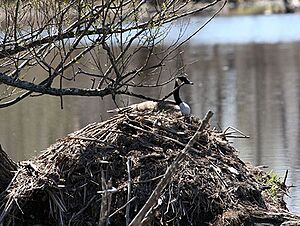
Many animals hunt Canada goose eggs and goslings. These include coyotes, foxes, raccoons, and large gulls. Ravens and crows also eat their eggs. Bears can also be a threat. Pet dogs can sometimes hunt geese, so it's important to keep dogs on a leash.
Adult Canada geese are large and can be aggressive. This means they are rarely hunted by other animals. But if they are hurt, they might be easier targets. Wolves and coyotes can hunt adult geese. Large birds like snowy owls, golden eagles, and bald eagles also hunt them. Geese are very careful around humans if they are hunted. But in places where people feed them, they can become very bold. They might even act aggressively if they feel bothered.
Canada Geese and People
In North America, the number of Canada geese that don't migrate is growing. You can often see them on golf courses, in parking lots, and in city parks. These places used to only see migrating geese sometimes. Because they can adapt to human areas, they are now one of the most common waterfowl in North America.
In many places, these non-migratory geese are seen as a problem. Their droppings can cause issues at beaches. People try different ways to manage them. These include making loud noises, using dogs to scare them, and having special hunting seasons. Conservationists try to focus hunting on the geese that stay all year. This helps protect the geese that follow their natural migration patterns.
In the United States, Canada geese are protected from hunting outside of certain seasons. This is under the Migratory Bird Treaty Act. In Canada, they are protected by the Migratory Birds Convention Act. It is usually against the law to buy or sell wild goose meat. Also, disturbing their nests or eggs is often restricted. In the UK, their nests and eggs are protected by law.
Geese can attack people if they feel their babies or themselves are in danger. First, they stand tall, spread their wings, and hiss. Then, they might charge and peck or hit with their wings.
Geese and Airplanes
Canada geese have been involved in many bird strikes with airplanes. Their large size and habit of flying in flocks can make these strikes serious. In the United States, Canada geese are the second most common bird to cause damage to airplanes. These strikes can cause planes to lose power in their engines.
For example, in 2009, a plane called US Airways Flight 1549 hit a flock of Canada geese. Both engines stopped working. The pilots had to land the plane on the Hudson River. Everyone on board survived. After such events, people work to prevent them. They change habitats, use scare tactics, or move geese away from airports.
Goose Meat
Canada geese are a common target for hunters, especially in North America. Some people describe their meat as "good, lean, rich meat." However, others say they are "amongst the most inedible of birds." In 2013–14, over 1.3 million geese were hunted in the U.S.
Canada geese are rarely raised on farms. Selling wild Canada goose meat is not common due to rules and because slaughterhouses are not used to wild birds. Sometimes, geese from city parks are given to food banks.
How Many Canada Geese Are There?
In 2000, there were an estimated 4 to 5 million Canada geese in North America. A study in Wichita, Kansas, found that the number of geese staying for winter grew a lot. From 1983 to 2003, the population went from 1,600 to over 18,000 birds.
Images for kids
-
Pair of adults with goslings, Norfolk
-
Family of Canada Geese in Ontario
-
Flock swimming in Huntsville, Ontario
-
Flying, New Jersey
-
Male Canada goose carefully watches nearby humans in Winnipeg
-
A Canada goose in Daingerfield State Park in Austin County, Texas, United States
-
Approaching to beg for food in a Manchester park, a learned behavior
See also
 In Spanish: Barnacla canadiense para niños
In Spanish: Barnacla canadiense para niños



